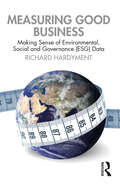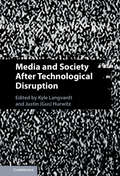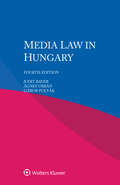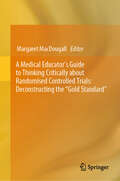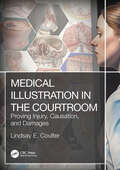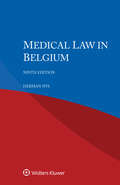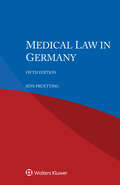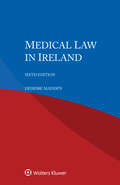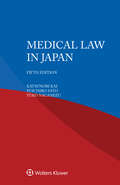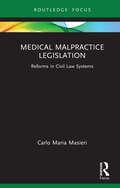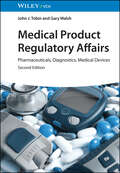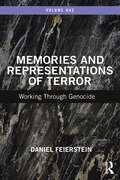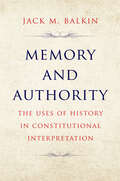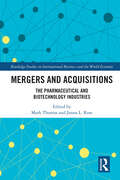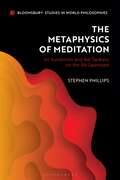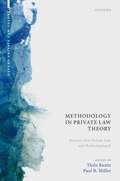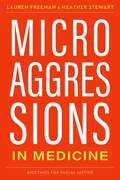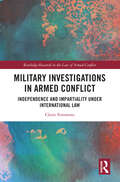- Table View
- List View
Measuring Good Business: Making Sense of Environmental, Social and Governance (ESG) Data
by Richard HardymentWhat's a good company? Environmental, Social and Governance (ESG) investing is transforming the world of business and finance. Investors are using data on issues like climate and diversity to enhance returns and make an impact. But with scepticism creeping in, how far can we trust the numbers? Is all this data making a difference to people and planet, and have we actually lost sight of what we are measuring and why? Measuring Good Business explains what we can measure – and calls for honesty about what we can't.This is the first book to look at the numbers behind the ESG revolution. It sets out a bold blueprint to revolutionise the data based on bottom-up, inclusive metrics, customised data to meet investor needs and impact measures that put sustainability in context. It is essential reading for anyone creating, using or studying ESG and sustainability data. After unpacking what’s going on today, the book focuses on solutions, providing a how-to guide to improve measurement and make sustainable business more impactful. It shows why measurement matters in a highly accessible way through stories and insights based on practical experience.The book is relevant to a broad readership of data creators (e.g. those working in companies), users (e.g. capital market participants) as well as the large ecosystem of raters, rankers and standard setters across the private, public and non-profit worlds.
Media and Society After Technological Disruption
by Kyle Langvardt Gus HurwitzThe internet has reshaped the media landscape and the social institutions built upon it. Competition from online media sources has decimated local journalism and diminished the twentieth century's established journalistic gatekeepers. Social media puts individual users front and center in the creation of the content that they consume. Harmful speech can spread further and faster, and the institutions responsible for policing that speech-Facebook, TikTok, YouTube and the like-lack any clear twentieth-century analog. The law is still working to catch up to the world these changes have wrought. This volume gathers sixteen scholars in law, media, technology, and history to consider these changes. Chapters explore the breakdown of trust in the media, changes in the law of defamation and privacy, challenges of online content moderation, and financial viability for journalistic enterprises in the internet age. This title is also available as Open Access on Cambridge Core.
Media Law in Hungary
by Judit Bayer Ágnes Urbán Gábor PolyákDerived from the renowned multi-volume International Encyclopaedia of Laws, this analysis of media law in Hungary surveys the massively altered and enlarged legal landscape traditionally encompassed in laws pertaining to freedom of expression and regulation of communications. Everywhere, a shift from mass media to mass self-communication has put enormous pressure on traditional law models. An introduction describing the main actors and salient aspects of media markets is followed by in-depth analyses of print media, radio and television broadcasting, the Internet, commercial communications, political advertising, concentration in media markets, and media regulation. Among the topics that arise for discussion are privacy, cultural policy, protection of minors, competition policy, access to digital gateways, protection of journalists’ sources, standardization and interoperability, and liability of intermediaries. Relevant case law is considered throughout, as are various ethical codes. A clear, comprehensive overview of media legislation, case law, and doctrine, presented from the practitioner’s point of view, this book is a valuable time-saving resource for all concerned with media and communication freedom. Lawyers representing parties with interests in Hungary will welcome this very useful guide, and academics and researchers will appreciate its value in the study of comparative media law.
A Medical Educator's Guide to Thinking Critically about Randomised Controlled Trials: Deconstructing the "Gold Standard"
by Margaret MacDougallDrawing on the statistical and philosophical expertise of its authors, this book is designed to improve understanding and use of randomised controlled trials (RCTs) among health professionals. It is intended for use primarily by medical educators involved in teaching statistics and evidence-based medicine (EBM) to medical students, junior doctors and other health professionals. However, each of the chapters serves a wider range of interests, including the practical needs of physicians in interpreting research evidence to support clinical decision making and the teaching needs of philosophers of medicine who want to more fully appreciate how RCTs work in practice and provide engaging examples for their students. Rather than compete with the proliferating methodological literature on RCT designs, this book focuses on cultivating a healthy skepticism among developing health professionals to support critical appraisal of their own and published work on RCTs at a fundamental level, including through a more informed understanding of the place of subgroup analyses in sound statistical inference. Management of the positive predictive value in the statistical analysis of RCT findings is included as an important topic for contemporary medical curricula. In comparing RCTs with non-randomised studies, a search for empirical evidence for the superiority of RCTs is initiated, pointing to the need for further work to confirm what form this evidence should take.Medical educators will find a wealth of reasons to encourage their students to think more critically about how the RCT operates in practice as a gold standard.
Medical Illustration in the Courtroom: Proving Injury, Causation, and Damages
by Lindsay E. CoulterMedical Illustration in the Courtroom: Proving Injury, Causation, and Damages educates the reader on how to communicate science visually—in personal injury, medical malpractice, criminal, and forensic cases—by creating art that utilizes medical records, radiographs, and computer software. Medical illustration bridges the gap between complex technical, medical, and scientific concepts to clearly illustrate, and explain visually, a medical condition, negligence, or the causation of an injury or death to the lay person. Medical artists are frequently challenged with illustrating injuries and medical conditions that can’t be seen by the naked eye. And while using medical photography and imaging for illustrative purposes can be helpful, to an untrained eye it can often be unclear or confusing. This is where the medical illustrator enters the equation. There are often patients who have recovered from an injury or infection that appear in good health. However, should an unforeseen injury or fatality happen, medical illustrators can reveal to people what’s actually going on inside the person, an invaluable asset to attorneys in the courtroom—especially for personal injury and medical malpractice cases. While many attorneys utilize medical artists, nonvisual people don’t always recognize the value of demonstrative aids until they see them first-hand.When attorneys and their clients enlist the aid of medical artists, it quickly becomes apparent that properly conceived and executed artwork is invaluable to illustrating the facts—and medical impacts—of any number of scenarios: homicides by shooting, stabbings, vehicular accidents, in addition to medical malpractice and personal injuries resulting from surgery or possible negligence.Presenting a myriad of services and computer technologies that can be utilized, Medical Illustration in the Courtroom provides demonstrative aids used in cases to illustrate personal injury and medical malpractice, employing "tricks of the trade" to create an accurate effective image. Such images are educational to attorneys, insurance adjusters, judges, and juries to help create a visual storyline, the goal being to help combine art and science to provide a clear illustration of events to help in adjudicate legal and forensic cases.
Medical Illustration in the Courtroom: Proving Injury, Causation, and Damages
by Lindsay E. CoulterMedical Illustration in the Courtroom: Proving Injury, Causation, and Damages educates the reader on how to communicate science visually—in personal injury, medical malpractice, criminal, and forensic cases—by creating art that utilizes medical records, radiographs, and computer software. Medical illustration bridges the gap between complex technical, medical, and scientific concepts to clearly illustrate, and explain visually, a medical condition, negligence, or the causation of an injury or death to the lay person. Medical artists are frequently challenged with illustrating injuries and medical conditions that can’t be seen by the naked eye. And while using medical photography and imaging for illustrative purposes can be helpful, to an untrained eye it can often be unclear or confusing. This is where the medical illustrator enters the equation. There are often patients who have recovered from an injury or infection that appear in good health. However, should an unforeseen injury or fatality happen, medical illustrators can reveal to people what’s actually going on inside the person, an invaluable asset to attorneys in the courtroom—especially for personal injury and medical malpractice cases. While many attorneys utilize medical artists, nonvisual people don’t always recognize the value of demonstrative aids until they see them first-hand.When attorneys and their clients enlist the aid of medical artists, it quickly becomes apparent that properly conceived and executed artwork is invaluable to illustrating the facts—and medical impacts—of any number of scenarios: homicides by shooting, stabbings, vehicular accidents, in addition to medical malpractice and personal injuries resulting from surgery or possible negligence.Presenting a myriad of services and computer technologies that can be utilized, Medical Illustration in the Courtroom provides demonstrative aids used in cases to illustrate personal injury and medical malpractice, employing "tricks of the trade" to create an accurate effective image. Such images are educational to attorneys, insurance adjusters, judges, and juries to help create a visual storyline, the goal being to help combine art and science to provide a clear illustration of events to help in adjudicate legal and forensic cases.
Medical Law in Belgium
by Herman NysDerived from the renowned multi-volume International Encyclopaedia of Laws, this convenient volume provides comprehensive analysis of the law affecting the physician-patient relationship in Belgium. Cutting across the traditional compartments with which lawyers are familiar, medical law is concerned with issues arising from this relationship, and not with the many wider juridical relations involved in the broader field of health care law. After a general introduction, the book systematically describes law related to the medical profession, proceeding from training, licensing, and other aspects of access to the profession, through disciplinary and professional liability and medical ethics considerations and quality assurance, to such aspects of the physician-patient relationship as rights and duties of physicians and patients, consent, privacy, and access to medical records. Also covered are specific issues such as organ transplants, human medical research, abortion, and euthanasia, as well as matters dealing with the physician in relation to other health care providers, health care insurance, and the health care system. Succinct and practical, this book will prove to be of great value to professional organizations of physicians, nurses, hospitals, and relevant government agencies. Lawyers representing parties with interests in Belgium will welcome this very useful guide, and academics and researchers will appreciate its comparative value as a contribution to the study of medical law in the international context.
Medical Law in Germany
by Jens PrüttingDerived from the renowned multi-volume International Encyclopaedia of Laws, this convenient volume provides comprehensive analysis of the law affecting the physician-patient relationship in Germany. Cutting across the traditional compartments with which lawyers are familiar, medical law is concerned with issues arising from this relationship, and not with the many wider juridical relations involved in the broader field of health care law. After a general introduction, the book systematically describes law related to the medical profession, proceeding from training, licensing, and other aspects of access to the profession, through disciplinary and professional liability and medical ethics considerations and quality assurance, to such aspects of the physician-patient relationship as rights and duties of physicians and patients, consent, privacy, and access to medical records. Also covered are specific issues such as organ transplants, human medical research, abortion, and euthanasia, as well as matters dealing with the physician in relation to other health care providers, health care insurance, and the health care system. Succinct and practical, this book will prove to be of great value to professional organizations of physicians, nurses, hospitals, and relevant government agencies. Lawyers representing parties with interests in Germany will welcome this very useful guide, and academics and researchers will appreciate its comparative value as a contribution to the study of medical law in the international context.
Medical Law in Ireland
by Deirdre MaddenDerived from the renowned multi-volume International Encyclopaedia of Laws, this convenient volume provides comprehensive analysis of the law affecting the physician-patient relationship in Ireland. Cutting across the traditional compartments with which lawyers are familiar, medical law is concerned with issues arising from this relationship, and not with the many wider juridical relations involved in the broader field of health care law. After a general introduction, the book systematically describes law related to the medical profession, proceeding from training, licensing, and other aspects of access to the profession, through disciplinary and professional liability and medical ethics considerations and quality assurance, to such aspects of the physician-patient relationship as rights and duties of physicians and patients, consent, privacy, and access to medical records. Also covered are specific issues such as organ transplants, human medical research, abortion, and euthanasia, as well as matters dealing with the physician in relation to other health care providers, health care insurance, and the health care system. Succinct and practical, this book will prove to be of great value to professional organizations of physicians, nurses, hospitals, and relevant government agencies. Lawyers representing parties with interests in Ireland will welcome this very useful guide, and academics and researchers will appreciate its comparative value as a contribution to the study of medical law in the international context.
Medical Law in Japan
by Katsunori Kai Yuichiro Sato Yuko NagamizuDerived from the renowned multi-volume International Encyclopaedia of Laws, this convenient volume provides comprehensive analysis of the law affecting the physician-patient relationship in Japan. Cutting across the traditional compartments with which lawyers are familiar, medical law is concerned with issues arising from this relationship, and not with the many wider juridical relations involved in the broader field of health care law. After a general introduction, the book systematically describes law related to the medical profession, proceeding from training, licensing, and other aspects of access to the profession, through disciplinary and professional liability and medical ethics considerations and quality assurance, to such aspects of the physician-patient relationship as rights and duties of physicians and patients, consent, privacy, and access to medical records. Also covered are specific issues such as organ transplants, human medical research, abortion, and euthanasia, as well as matters dealing with the physician in relation to other health care providers, health care insurance, and the health care system. Succinct and practical, this book will prove to be of great value to professional organizations of physicians, nurses, hospitals, and relevant government agencies. Lawyers representing parties with interests in Japan will welcome this very useful guide, and academics and researchers will appreciate its comparative value as a contribution to the study of medical law in the international context.
Medical Malpractice Legislation: Reforms in Civil Law Systems (Young Feltrinelli Prize in the Moral Sciences)
by Carlo Maria MasieriThis book aims to analyse the legal tools that the legislatures of France, Germany and Italy adopted in order to regulate medical malpractice.In the mid-1970s, a reform movement started in the United States, where there was considerable concern about then ongoing medical malpractice crises. Since the beginning of the current century, France, Germany and Italy have passed statutes that aim to reform medical liability rules. Thus, it is first interesting to assess whether any medical malpractice crises have been identified in these systems and, second, how these have been faced through the passing of new statutes on the continent. Accordingly, the first chapter explores the idea of medical malpractice crisis and its relationship with the insurance market, also considering the reflections of American scholars. It then reconstructs the French, German and Italian legal frameworks, as well as their insurance and litigation contexts, reviewing and commenting on the quantitative evidence that was collected before the reforms. The second chapter briefly summarises the debate on medical malpractice reforms in France, Germany and Italy. It then analyses the statutes that have been passed, distinguishing between reforms that consolidate case law and reforms that introduce innovative solutions, sometimes repealing court-developed doctrines. In particular, the chapter examines in a comparative perspective the diff erent options adopted in these civil law countries with regard to the rules on liability, burden of proof, statute of limitations and damages. Moreover, the chapter examines the reforms of insurance, procedural and evidence law, to the extent they affect medical malpractice cases. The third chapter reviews and analyses the current available data related to medical malpractice litigation and insurance after the reforms adopted in France, Germany and Italy, in order to find out evidence of their effectiveness and efficiency. It also highlights some aspects of medical malpractice law that still belong to the domain of the judiciary. It finally points out which problems may be addressed by the legislatures and what further data should be collected in the future.This work may interest legal scholars, healthcare providers, insurers and policymakers.
Medical Malpractice Legislation: Reforms in Civil Law Systems (Young Feltrinelli Prize in the Moral Sciences)
by Carlo Maria MasieriThis book aims to analyse the legal tools that the legislatures of France, Germany and Italy adopted in order to regulate medical malpractice.In the mid-1970s, a reform movement started in the United States, where there was considerable concern about then ongoing medical malpractice crises. Since the beginning of the current century, France, Germany and Italy have passed statutes that aim to reform medical liability rules. Thus, it is first interesting to assess whether any medical malpractice crises have been identified in these systems and, second, how these have been faced through the passing of new statutes on the continent. Accordingly, the first chapter explores the idea of medical malpractice crisis and its relationship with the insurance market, also considering the reflections of American scholars. It then reconstructs the French, German and Italian legal frameworks, as well as their insurance and litigation contexts, reviewing and commenting on the quantitative evidence that was collected before the reforms. The second chapter briefly summarises the debate on medical malpractice reforms in France, Germany and Italy. It then analyses the statutes that have been passed, distinguishing between reforms that consolidate case law and reforms that introduce innovative solutions, sometimes repealing court-developed doctrines. In particular, the chapter examines in a comparative perspective the diff erent options adopted in these civil law countries with regard to the rules on liability, burden of proof, statute of limitations and damages. Moreover, the chapter examines the reforms of insurance, procedural and evidence law, to the extent they affect medical malpractice cases. The third chapter reviews and analyses the current available data related to medical malpractice litigation and insurance after the reforms adopted in France, Germany and Italy, in order to find out evidence of their effectiveness and efficiency. It also highlights some aspects of medical malpractice law that still belong to the domain of the judiciary. It finally points out which problems may be addressed by the legislatures and what further data should be collected in the future.This work may interest legal scholars, healthcare providers, insurers and policymakers.
Medical Product Regulatory Affairs: Pharmaceuticals, Diagnostics, Medical Devices
by John J. Tobin Gary WalshMedical Product Regulatory Affairs Hands-on guide through the jungle of medical regulatory affairs for every professional involved in bringing new products to market Based on a module prepared by the authors for an MSc course offered by the University of Limerick, Ireland, Medical Product Regulatory Affairs is a comprehensive and practical guide on how pharmaceutical and medical devices are regulated within the major global markets. The Second Edition builds on the success of the first with an even wider scope and full coverage of new EU regulations on the safe use of medical devices. Following a look at drug development, complete sections are devoted to national and EU regulatory issues, manufacturing license application and retention, and regulation in the USA. Other topics dealt with include CDER, CBER and marketing and manufacturing licenses, the ICH process and Good Laboratory/Clinical/ Manufacturing Practices. Medical Product Regulatory Affairs includes information on: Aims and structure of regulation, covering purpose and principles of regulation, national and EU legislative processes, and pharmacopeia Regulatory strategy, covering product development and manufacturing, market vigilance, quality assurance systems, personnel, and documentation Drug discovery and development, covering prescription status, physical properties, therapeutic use, and drug discovery, development, and delivery Non-clinical studies, covering non-clinical study objectives and timing, pharmacological and pharmacodynamic studies, and bioavailability and bioequivalence Clinical trials, covering trial protocol, monitoring of trials, trial master files, and FDA communications The wide coverage of different product types and the main global markets makes Medical Product Regulatory Affairs ideal for training courses on regulatory affairs in academia and industry. It is also a valuable reference for pharmacologists, bioengineers, pharma engineers, and students in pharmacy to familiarize themselves with the topic.
Medical Product Regulatory Affairs: Pharmaceuticals, Diagnostics, Medical Devices
by John J. Tobin Gary WalshMedical Product Regulatory Affairs Hands-on guide through the jungle of medical regulatory affairs for every professional involved in bringing new products to market Based on a module prepared by the authors for an MSc course offered by the University of Limerick, Ireland, Medical Product Regulatory Affairs is a comprehensive and practical guide on how pharmaceutical and medical devices are regulated within the major global markets. The Second Edition builds on the success of the first with an even wider scope and full coverage of new EU regulations on the safe use of medical devices. Following a look at drug development, complete sections are devoted to national and EU regulatory issues, manufacturing license application and retention, and regulation in the USA. Other topics dealt with include CDER, CBER and marketing and manufacturing licenses, the ICH process and Good Laboratory/Clinical/ Manufacturing Practices. Medical Product Regulatory Affairs includes information on: Aims and structure of regulation, covering purpose and principles of regulation, national and EU legislative processes, and pharmacopeia Regulatory strategy, covering product development and manufacturing, market vigilance, quality assurance systems, personnel, and documentation Drug discovery and development, covering prescription status, physical properties, therapeutic use, and drug discovery, development, and delivery Non-clinical studies, covering non-clinical study objectives and timing, pharmacological and pharmacodynamic studies, and bioavailability and bioequivalence Clinical trials, covering trial protocol, monitoring of trials, trial master files, and FDA communications The wide coverage of different product types and the main global markets makes Medical Product Regulatory Affairs ideal for training courses on regulatory affairs in academia and industry. It is also a valuable reference for pharmacologists, bioengineers, pharma engineers, and students in pharmacy to familiarize themselves with the topic.
Memories and Representations of Terror: Working Through Genocide
by Daniel FeiersteinMemories and Representations of Terror: Working Through Genocide explores how memories and representations shape our understanding of historical events, particularly the ways in which societies create narratives about genocide and its aftermath, using Argentina’s last military dictatorship (1976–1983) and its contested legacy as a case study. Feierstein examines how memories and representations of genocide are the terrain in which both the strategic objectives of genocide and the possibilities of challenging those objectives are contested. These memories and representations provide the foundation upon which critical judgments about the past are constructed and offer the potential for assuming responsibility and working through the consequences of genocide. This book proposes that terror continues to hijack the actions and identities of surviving societies via a process of the construction of memories and social representations of the lived experience in a final stage of genocide Feierstein terms "symbolic enactment". In doing so, Feierstein examines the contributions of various disciplines to comprehending memory processes and social representations. It covers a range of topics, from the nature of memory based on the neuroscientific discoveries of the last half-century to psychoanalytic theories on the functioning of the mind, including the role of psychic defense mechanisms, the unconscious mind, collective pacts of denial and different forms of desensitization. It also explores historiographical debates between forms of history and forms of memory, as well as sociological contributions to the analysis of social frames of memory, cultural memory, generational transmission and related issues. The first volume of a three-volume work that aims to identify and evaluate the various consequences of genocidal social practices and the possibility of healing the scars left on individuals’ subjectivities and the social fabric by genocide. This book is essential reading for students and academics in the humanities and social sciences with an interest in genocide, collective memory and identity.
Memories and Representations of Terror: Working Through Genocide
by Daniel FeiersteinMemories and Representations of Terror: Working Through Genocide explores how memories and representations shape our understanding of historical events, particularly the ways in which societies create narratives about genocide and its aftermath, using Argentina’s last military dictatorship (1976–1983) and its contested legacy as a case study. Feierstein examines how memories and representations of genocide are the terrain in which both the strategic objectives of genocide and the possibilities of challenging those objectives are contested. These memories and representations provide the foundation upon which critical judgments about the past are constructed and offer the potential for assuming responsibility and working through the consequences of genocide. This book proposes that terror continues to hijack the actions and identities of surviving societies via a process of the construction of memories and social representations of the lived experience in a final stage of genocide Feierstein terms "symbolic enactment". In doing so, Feierstein examines the contributions of various disciplines to comprehending memory processes and social representations. It covers a range of topics, from the nature of memory based on the neuroscientific discoveries of the last half-century to psychoanalytic theories on the functioning of the mind, including the role of psychic defense mechanisms, the unconscious mind, collective pacts of denial and different forms of desensitization. It also explores historiographical debates between forms of history and forms of memory, as well as sociological contributions to the analysis of social frames of memory, cultural memory, generational transmission and related issues. The first volume of a three-volume work that aims to identify and evaluate the various consequences of genocidal social practices and the possibility of healing the scars left on individuals’ subjectivities and the social fabric by genocide. This book is essential reading for students and academics in the humanities and social sciences with an interest in genocide, collective memory and identity.
Memory and Authority: The Uses of History in Constitutional Interpretation (Yale Law Library Series in Legal History and Reference)
by Jack M. BalkinFrom one of the nation’s preeminent constitutional scholars, a sweeping rethinking of the uses of history in constitutional interpretation Fights over history are at the heart of most important constitutional disputes in America. The Supreme Court’s current embrace of originalism is only the most recent example of how lawyers and judges try to use history to establish authority for their positions. Jack M. Balkin argues that fights over constitutional interpretation are often fights over collective memory. Lawyers and judges construct—and erase—memory to lend authority to their present-day views; they make the past speak their values so they can then claim to follow it. The seemingly opposed camps of originalism and living constitutionalism are actually mirror images of a single phenomenon: how lawyers use history to adapt an ancient constitution to a constantly changing world. Balkin shows how lawyers and judges channel history through standard forms of legal argument that shape how they use history and even what they see in history. He explains how lawyers and judges invoke history selectively to construct authority for their claims and undermine the authority of opposing views. And he elucidates the perpetual quarrel between historians and lawyers, showing how the two can best join issue in legal disputes. This book is a sweeping rethinking of the uses of history in constitutional interpretation.
Merger Control, National Security, and Foreign Direct Investment Screening: A Comparative Perspective
by Ioannis KokkorisThe Covid-19 pandemic, the significant expansion of the Chinese investment abroad, and recent geo-political tensions have all served to strengthen national security considerations in merger control and foreign direct investment (FDI) processes. Against this backdrop, Merger Control, National Security, and Foreign Direct Investment Screening: A Comparative Perspective provides a comprehensive exploration of the intricate interplay between national security, foreign direct investment, and competition policy in an increasingly interconnected global economy. Central to the book's analysis is the exploration of FDI screening mechanisms from a national security perspective as they apply to Merger and Acquisition (M&A) transactions. Spanning a wide array of jurisdictions, industries, and policy contexts, including case studies from major economies such as the European Union, the United Kingdom, the United States, and China, the book examines how lawmakers navigate protecting their strategic sectors while promoting a welcoming environment for investors. It also showcases how competition authorities grapple with incorporating broader societal goals and national security concerns into merger control assessments. Merger Control, National Security, and Foreign Direct Investment Screening scrutinizes the challenges of balancing these objectives while maintaining the integrity of competition law principles and avoiding undue political influence. It offers a thought-provoking and timely guide for policymakers, practitioners, scholars, and stakeholders seeking to navigate the intricacies of global economic interdependence without dismissing national interests.
Mergers and Acquisitions: The Pharmaceutical and Biotechnology Industries (Routledge Studies in International Business and the World Economy)
by Mark Thomas Janna L. RoseCovid-19 has brought so much uncertainty, but one certainty is that the vaccine race will generate winners and losers in the pharmaceutical and biotechnology industries. This will have a major impact on merger and acquisition activity. While the plethora of merger and acquisition deals are abundantly reported by the news media, there is a clear lack of in-depth analysis on the multiple rationales and various challenges in the life sciences industry. By offering contributions from a variety of experts in the biotechnology and pharmaceutical industries, as well as experts on mergers and acquisitions, this edited collection will draw upon the knowledge of a variety of different actors within the fields of pharma and biotech. This book offers a timely exploration of the complexities of mergers and acquisitions in the pharmaceutical and biotechnology industries while seeking to bridge the gap between theory and practice. It presents a critical analysis of the rationale for acquisitions and studies the challenges of ensuring a successful deal. In the light of the Covid-19 pandemic, it will also explore the impact this may have on the industry, which may further stimulate merger and acquisition activity. It will be of interest to researchers, academics, policymakers, and students in the fields of strategy, management, governance, and the biotechnology and pharmaceutical industries.
Mergers and Acquisitions: The Pharmaceutical and Biotechnology Industries (Routledge Studies in International Business and the World Economy)
by Mark Thomas Janna L. RoseCovid-19 has brought so much uncertainty, but one certainty is that the vaccine race will generate winners and losers in the pharmaceutical and biotechnology industries. This will have a major impact on merger and acquisition activity. While the plethora of merger and acquisition deals are abundantly reported by the news media, there is a clear lack of in-depth analysis on the multiple rationales and various challenges in the life sciences industry. By offering contributions from a variety of experts in the biotechnology and pharmaceutical industries, as well as experts on mergers and acquisitions, this edited collection will draw upon the knowledge of a variety of different actors within the fields of pharma and biotech. This book offers a timely exploration of the complexities of mergers and acquisitions in the pharmaceutical and biotechnology industries while seeking to bridge the gap between theory and practice. It presents a critical analysis of the rationale for acquisitions and studies the challenges of ensuring a successful deal. In the light of the Covid-19 pandemic, it will also explore the impact this may have on the industry, which may further stimulate merger and acquisition activity. It will be of interest to researchers, academics, policymakers, and students in the fields of strategy, management, governance, and the biotechnology and pharmaceutical industries.
The Metaphysics of Meditation: Sri Aurobindo and Adi-Sakara on the Isa Upanisad (Bloomsbury Studies in World Philosophies)
by Stephen PhillipsIn this book Stephen Phillips focuses on one of the most important poems about meditation in world literature, as understood by two of the greatest philosophers of India, one classical, one modern. Sankara's commentaries on the Upanisads are a core of the Vedanta tradition and Aurobindo is a towering figure of 20th-century Hindu thought. This is the first time their approaches have been studied together.The Isa (c. 500 BCE) an “Upanisad” belongs to a genre of “adhyatmika” learning-concerning self and consciousness-in early Indian literature. According to the Ancient Indian tradition of yoga, meditation is antithetical to willful bodily and mental action. Breathing is all you do. In the conception of the Isa Upanisad, we are told that the best that comes from meditation is because of what the “Lord” is. In Sankara's interpretation it comes to block out the little “you,” whereas according to Aurobindo it comes as a divine connection, an occult “Conscious Force” belonging to truer part of oneself, atman, and an “opening” to that self's native energy. Framed around Aurobindo's translation of each of the Isa's eighteen verses, along with a translation of each verse, Phillips follows a different reading of Sankara as laid out in his commentary. All this is done against the backdrop of modern scholarship. Convergences and divergences of these streams are the focus throughout. Appendix A presents the Upanisad with the two readings side by side.This book traces a worldview and consonant yoga teaching common to two authors who are typically taken to be oceans apart, not only chronologically but in intellectual stance. Addressing a huge gap in the contemporary literature on meditation in the Hindu traditions, Phillips presents a compelling new way of thinking about meditation in the Advaita Vedanta philosophy and Upanisad.
Methodology in Private Law Theory: Between New Private Law and Rechtsdogmatik (Oxford Private Law Theory)
by Thilo Kuntz Paul B. MillerMethodology in Private Law Theory: Between New Private Law and Rechtsdogmatik represents a first-of-its-kind dialogue between leading lights in German and American private law theory. The chapters in this volume build upon established traditions of scholarship in German private law and harness resurgent scholarly interest in private law in the United States, inviting readers to question how private law functions on both sides of the Atlantic. In the context of the cross-fertilization of legal scholarship, the transnationalization of law, and the historical ties between US and German debates on methodology, the volume encourages reasoned engagement with private law doctrines and institutions. It further invites reflexive consideration of diverse ways in which methods of legal analysis influence social practices where law is given, received, asserted, and negotiated. Leading methodologies of the past and present are subject to fresh elucidation and insightful criticism, including those of legal formalism, legal conceptualism, legal realism, law and economics, legal philosophy, legal history, empirical jurisprudence, Rechtsdogmatik, and other varieties of doctrinal scholarship. Providing the necessary background for understanding different legal cultures and traditions in private law, Methodology in Private Law Theory is a must-read for anyone working within the field.
Microaggressions in Medicine (Bioethics for Social Justice)
by Lauren Freeman Heather StewartIn a world that too often marginalizes people based on their race, gender, sexual orientation, body size, or disability, medicine can often be no different. Far from ?doing no harm,? it treats some patients unfairly, leading to detrimental effects. Guided by diverse patient testimonies and case studies, Microaggressions in Medicine focuses on the harms that such patients face. It amplifies their voices, stories, and experiences, which have too-often been excluded from mainstream bioethical, medical, and popular discussions. Microaggressions in medicine are not rare, but frequent in the healthcare experiences of marginalized patients. Recognizing this can help patients better understand and make sense of their experiences. As bioethicists Lauren Freeman and Heather Stewart argue, building such an awareness can also help current and future healthcare professionals recognize the serious and enduring consequences that microaggressions have on their patients. Freeman and Stewart offer practical strategies for healthcare professionals to reduce microaggressions in their practices. The harms of microaggressions are anything but micro. Healthcare professionals have a moral obligation to prevent them as much as possible. Health equity can be achieved, but only through first recognizing the harm caused by microaggressions in medical contexts. Shining a light on microaggressions in medicine and offering concrete ways for health professionals to avoid them in the future will make a positive difference in the lives of marginalized patients as they interact with medical institutions and practitioners. All patients deserve high quality, patient-centered care but healthcare professionals must change their practices in order to achieve such equity.
Military Investigations in Armed Conflict: Independence and Impartiality under International Law (Routledge Research in the Law of Armed Conflict)
by Claire SimmonsAn allegation is made that a war crime was committed by a soldier during a conflict. Who should investigate the allegation? How should they investigate?This book explores a topic of critical importance in legal and policy discussions surrounding the accountability of military operations in armed conflict, and problematises some presumptions that are often made about the topic. The work provides the international legal framework necessary to address these questions and establishes the precise standards of independence and impartiality as applicable to investigations in armed conflict. It questions the assumption that the standards of independence and impartiality of investigations should be measured in the same way that we measure these standards for judges, courts, and tribunals. It also explores the ways in which military institutions and culture, as well as the context of armed conflict, may impact on the effectiveness of investigations or the perception of justice by those affected. By demonstrating the precise ways in which military investigations can contribute to or hinder the effectiveness of investigations, the book clarifies States’ responsibilities with regard to their accountability efforts for serious violations of international law in armed conflict. The work will be a valuable resource for academics, researchers, and policy-makers working in the areas of international humanitarian law, international human rights law, as well as political science and military ethics.
Military Investigations in Armed Conflict: Independence and Impartiality under International Law (Routledge Research in the Law of Armed Conflict)
by Claire SimmonsAn allegation is made that a war crime was committed by a soldier during a conflict. Who should investigate the allegation? How should they investigate?This book explores a topic of critical importance in legal and policy discussions surrounding the accountability of military operations in armed conflict, and problematises some presumptions that are often made about the topic. The work provides the international legal framework necessary to address these questions and establishes the precise standards of independence and impartiality as applicable to investigations in armed conflict. It questions the assumption that the standards of independence and impartiality of investigations should be measured in the same way that we measure these standards for judges, courts, and tribunals. It also explores the ways in which military institutions and culture, as well as the context of armed conflict, may impact on the effectiveness of investigations or the perception of justice by those affected. By demonstrating the precise ways in which military investigations can contribute to or hinder the effectiveness of investigations, the book clarifies States’ responsibilities with regard to their accountability efforts for serious violations of international law in armed conflict. The work will be a valuable resource for academics, researchers, and policy-makers working in the areas of international humanitarian law, international human rights law, as well as political science and military ethics.
